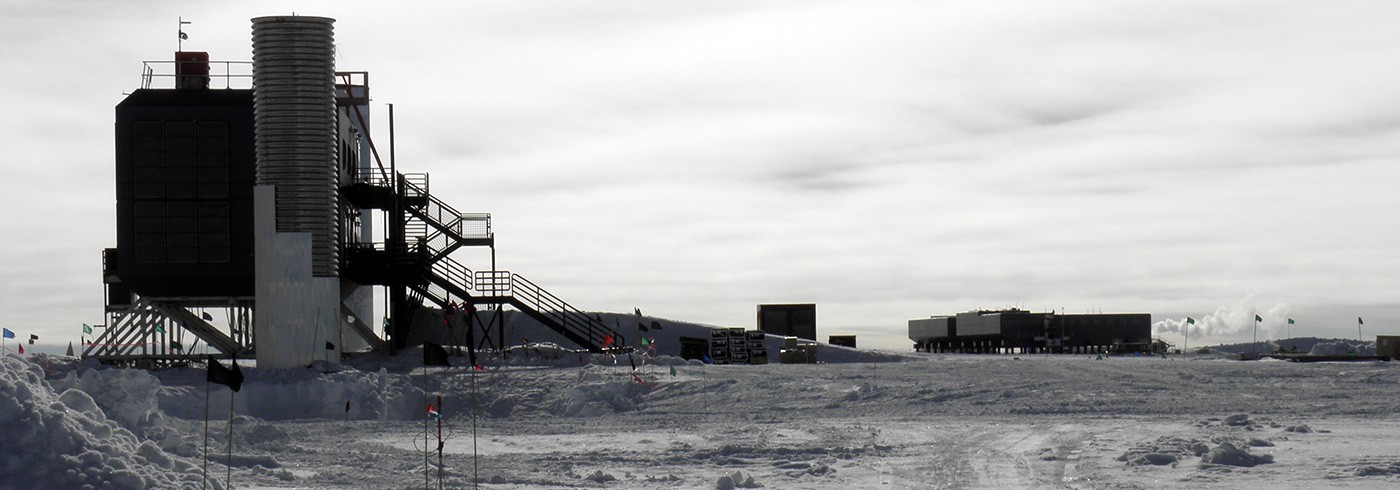Physics breakthrough with IceCube at the South Pole
1 January 2013 - 30 January 2013In 2013, Physics World editors called the discovery of high-energy neutrinos of cosmic origin the physics breakthrough of the year. This discovery was made at the IceCube neutrino telescope at the South Pole.
IceCube is currently the world’s leading neutrino telescope. The detector was built in the ice at the geographical South Pole, adjacent to the American Amundsen-Scott research station. Over
5 000 optical sensors were installed in the glacier ice at depths of 1 500–2 500 meters. The instrumented volume of ice measures 1 km3. The sensor installation began in 2004 and was completed in December 2010. Data extraction using the completed detector has been ongoing continuously since May 2011, although data were also gathered before that using the partly completed detector.
The first analysis that ultimately led to the discovery of high energy neutrinos of astrophysical origin was performed back in 2012, when we found two extremely high-energy events, just over 1 PeV (1015eV). These events were described in Physical Review Letters (Issue 111, 2013) in summer 2013. However, just two events were not enough to enable us to determine whether they derived from background processes or were of astrophysical origin. The properties of the events led to the development of a new way of filtering data to find events with their interaction vertex inside the detector. Using the new analysis, it became possible to lower the energy threshold without the background becoming overwhelming. The analysis yielded the two previously detected events, plus another 26 events with energy levels exceeding 0.05 PeV. It then became clear that many of the detected neutrinos must have been of cosmic origin. The discovery was described in the journal Science (Volume 342, Issue 6161, 2013), which featured a cover image of the hit distribution of a neutrino interaction within IceCube.
This discovery opens a new window through which to observe the universe. Neutrinos will yield information about the sources of cosmic radiation1 and about acceleration processes. No distinct source has yet been discerned in the first map of the events. Other researchers have already published some 50 scientific articles offering various explanations and theories for the discovered events.
IceCube achieved an important goal with the detection of these cosmic neutrinos. The collaboration is now planning to expand the detector so that the neutrino stream can be mapped more quickly, improving our understanding of how the universe is evolving. Plans are also in place to install an additional cluster of detectors in the centre of the detector to measure neutrinos with energies in the GeV range. The aim is to determine the relationships between the masses of the various neutrino types.
The collaboration published 18 scientific articles in 2013 and six more have been submitted. The results have also been presented at numerous conferences. The detector and the analytical methods have exceeded expectations in several areas. Data extraction is planned to continue for many years in order to achieve the ultimate sensitivity to the neutrino streams and to monitor time-dependent neutrino sources in the universe.
The IceCube collaboration is looking forward to data gathering and analyses in 2014 that could be very exciting for the field of neutrino astronomy.
1 Cosmic radiation was discovered over a century ago in 1929 when Viktor Hess ascended to an altitude of 5 000 meters in a balloon. He had expected the ionising radiation to decrease the farther he travelled from the earth’s surface, but found exactly the opposite. Much about the origins of this radiation still remains unknown.

